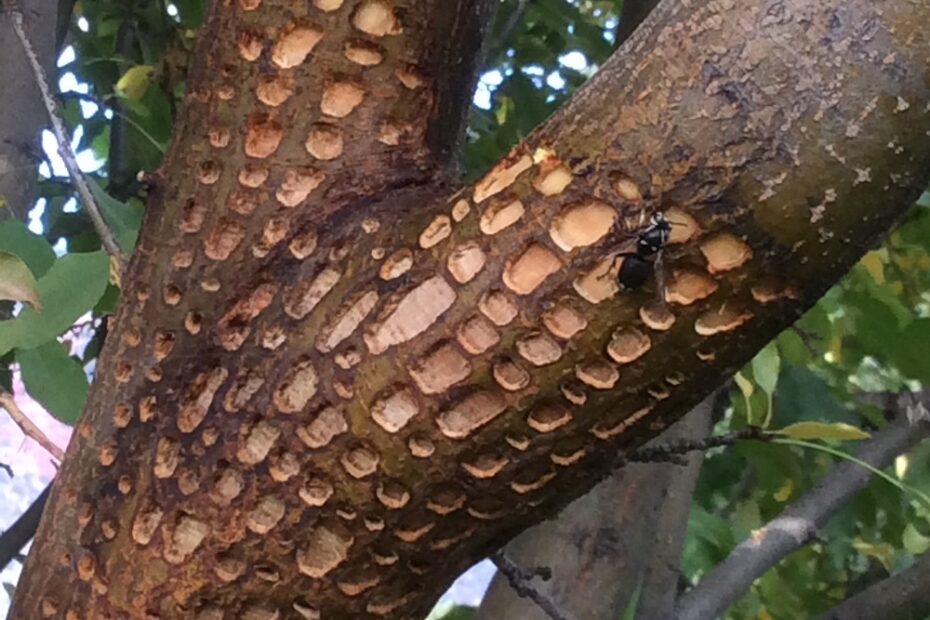While wasps and bees might appear similar in colour, they differ significantly in their roles and impact on the environment. Bees are crucial pollinators, essential for many of our food sources, and encouraging them in our gardens is beneficial. Wasps, however, can pose problems for our gardens and trees. By regularly maintaining your trees and taking specific preventative measures, you can protect them from potential wasp damage.
How Do Wasps Damage Trees?
Wasps can harm trees in several ways:
1. Nesting Damage: Certain wasp species, such as paper wasps and hornets, build nests by chewing wood fibres and mixing them with saliva to create a papery material. They often choose protected areas, including tree branches, crevices, or hollows. This activity can weaken the tree’s structure as they chew and excavate wood for nest construction.
2. Bark Damage: Some wasp species, such as wood-boring wasps or horntails, have larvae that bore into the wood of trees. These wasps lay their eggs inside the bark, and the larvae tunnel and feed on the tree’s inner tissues when they hatch. This can disrupt the flow of nutrients and leave visible exit holes on the bark, weakening the tree.
3. Sap Feeding: Wasps, particularly sap wasps, may feed on tree sap by piercing the bark with their mouthparts. This can lead to small wounds or openings in the bark. Excessive sap feeding can affect the tree’s health over time.
4. Indirect Effects: Wasps are predators and scavengers. In their search for prey or food, they may disturb or damage tree foliage, flowers, or fruits, impacting the tree’s overall health and productivity.
How Common Is the Issue?
The occurrence of wasp-related tree damage can vary based on the region, tree species, and local wasp populations:
- Nesting Damage: Fairly common but usually limited in extent unless the infestation is severe.
- Bark Damage: Less common than nesting damage, typically affecting weakened or stressed trees.
- Sap Feeding: Frequently encountered, especially during periods of high wasp activity.Many trees can withstand moderate sap feeding with minimal impact on their health.
- Indirect Effects: Wasps are attracted to ripe or decaying fruits, nectar-rich flowers, or other insects in trees, making their indirect effects common.
Most healthy trees can tolerate minor wasp activity, and regular maintenance helps mitigate potential issues.
Why Is Protecting Trees from Wasps Important?
Protecting trees from wasp damage is crucial for several reasons:
- Tree Health: Maintaining the overall health and longevity of trees.
- Aesthetics and Landscape Value: Ensuring trees remain visually pleasing and enhance the natural and cultural value of the surroundings.
- Ecological Balance: Supporting the interconnected web of life by maintaining the ecological integrity of the area.
- Safety: It helps minimise the risk of stings and allergic reactions, ensuring the safety of people and pets.
- Economic Considerations: Preserving the economic value of trees in urban landscapes, commercial properties, or natural forests.
How to Protect Trees from Wasp Damage
Here are some steps to prevent wasp damage to your trees:
1. Trim Branches and Remove Nests: Regularly inspect your trees for wasp nests and remove them promptly. If nests are in high or hard-to-reach areas, consider seeking professional help. Trimming overhanging branches can also help reduce the chances of wasps constructing nests.
2. Maintain Tree Health: Healthy trees are more resilient to damage. Ensure proper watering, fertilisation, and regular pruning to remove dead or weakened branches.
3. Seal Tree Wounds: Promptly seal any damage with appropriate tree wound sealant or paint to prevent access points for wasps and other insects.
4. Use Decoy Nests: Wasps are territorial and may avoid areas with existing nests. Using artificial decoy nests can deter wasps from establishing nests in your trees.
5. Reduce Attractants: Minimise food sources for wasps by cleaning up fallen fruit, securing garbage bins, and using wasp-proof fruit traps or covers.
6. Seek Professional Assistance: For persistent wasp problems or large infestations, consult a professional pest control service or arborist for effective management.
Remember, prioritise safety when dealing with wasps. If you are allergic to wasp stings or unsure about handling nests, it’s best to contact us. We have professionals who have the expertise and necessary equipment to address the issue safely.





